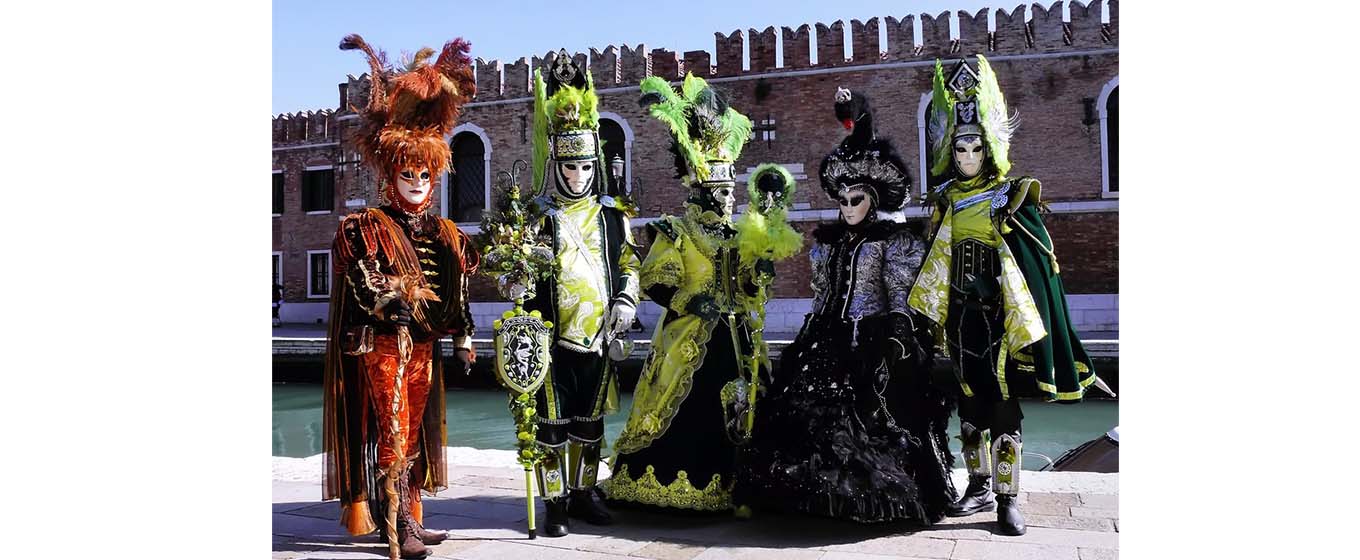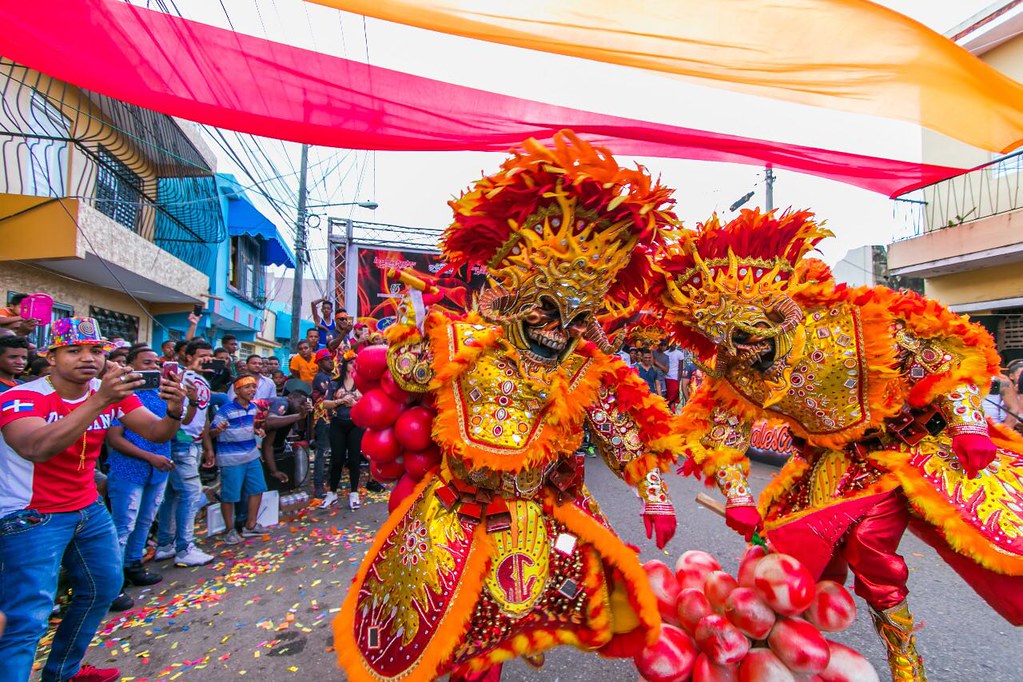Italy's Irresistible Carnival Traditions

by Adriana Maria Vargas Bermudez
Traditions paint the canvas of our lives, shaping our identities and colouring our perspectives. As an international student from the Dominican Republic, I carry the vibrant portrait of my roots with me wherever I go. But let's talk Carnival, shall we? Back home, it's like a symphony of laughter and rhythm, echoing through every province of the island with a harmonious blend of fun, joy, and a deep sense of community. It's the kind of celebration that binds us together and reminds us how proud we are to be Dominicans.
Now, arriving in Italy to my delight, I discover that Italians find that sense of community through the festivities of Carnival as well! It's not merely an event; it's a grand performance that draws people of all ages into its vibrant melody. And for a student away from home like me, it's like finding a familiar melody far from home – a comforting reminder of the universal language of celebration and togetherness. So, without further ado, let me invite you to join me on a journey through some of Italy's most illustrious carnivals. Get ready to be swept away by the symphony of joy and unity that will reach you right through the screen.

Venice Carnival
Tradition: Carnevale di Venezia originated back in the 11th Century as a street party in Venice to celebrate the end of winter before the Lenten season, a Christian celebration before Easter commemorating the 40 days Jesus Christ spent fasting. Over time, the festival evolved to include masquerade balls and participation from the aristocracy. Wearing masks during Carnevale allowed people to let go of social constraints and mingle across social classes. Carnevale traditionally lasted for six weeks between December 25th and Ash Wednesday. Fat Thursday (Giovedi Grasso) and Fat Tuesday (Shrove Thursday) were highlights of the carnival, with historical significance tied to Venice's victories and traditions.
Food: Fritelle: or fritole, is a sort of fried doughnut, filled with raisin, cream, chocolate or apple slices. Castagnole: are little fried balls of dough, served with icing sugar.
Carnival flavoured with oranges: the rite of Ivrea
Tradition: The central theme of Carnival in Ivrea dates to the late 18th century and revolves around a legend of local people rising against a feudal tyrant. The legend is commemorated on Carnival Sunday with a ceremony called the Preda in Dora, documented as far back as 1608. The ceremony decrees that no other towers or castles can be built on the site of the destroyed Castellazzo of the tyrant. In the 1800s, the Carnival became more bourgeois, but the arrival of the French and increased trade links introduced exotic oranges to Ivrea. Oranges were initially thrown as a tribute to the invaders but became part of the Historical Carnival Parade and evolved into a formal orange battle. The Battle of the Oranges symbolises freedom for the people, with teams wearing colours representing their respective factions.
Food: The morning of the Battle of the Oranges also sees another rite where everyone can, should and does participate. It is the free distribution of beans by the parishes of the town. The tradition of charity 'fagiolate' comes from medieval times when beans were precious food and portions were distributed by Ivrea confraternities to those less fortunate. Another typical dish is polenta and cod. It is traditionally eaten on Ash Wednesday, the first day of Lent.
Viareggio Carnival: masks and papier-mâché along the seafront
Tradition: Viareggio Carnival's floats are made primarily from papier-mâché, perfected by Antonio D’Arliano in 1925, utilising clay models, plaster casts, newspaper, and flour-and-water glue. This technique allows for the creation of large yet lightweight floats, some over 20 meters high and 12 meters wide, designed to impress and engage audiences during parades. The floats are crafted by 23 artisan companies in Viareggio's Citadel, involving hundreds of people in the creative process. Burlamacco, the official mask of the Viareggio Carnival since 1931, symbolises the event and belongs to the traditional masks of the Commedia dell’Arte. The Carnival floats are renowned for their scenic impact, colourful designs, lively figures, choreography, and spectacular movements, making them unique spectacles admired by many.
Food: Frittella di riso: a sweet rice fritter. Fagioli all’uccelletto with sausage, also another typical dish and finally Tordelli, a kind of meat-filled ravioli served with meat sauce, generally eaten to celebrate grass
A Carnival parade in Putignano, Puglia
Tradition: The protagonist of the Putignano Carnival is 'Farinella,' who first appeared in his current form in 1953. Farinella wears a green and white suit with a three-pointed hat, an obligatory mask, and bells on his shoes, representing the town's colours and symbolising a cat and a dog at peace. The carnival, one of the oldest in the world, began in 1394 and features a fabulous parade of floats, considered one of the longest carnivals. The carnival tradition began when the pilgrim crowd, upon the relics' arrival in Putignano, dusted their faces with flour to exhibit purity and attended a Mass, marking the birth of the carnival.
Food: Farinella: made from toasted barley and chickpeas which became the base for a tasty sauce of freshly picked figs, and the typical meal for those working in the fields.
Carnevale Ambrosiano - Carnival in Milan
Carnival is celebrated differently according to the Roman and Ambrosian rites. In the Roman rite, it's celebrated the Sunday following Shrove Thursday, while in the Ambrosian rite, it's celebrated the Saturday following Shrove Tuesday and Ash Wednesday. Menghino and La Cecca, characters invented by playwright Carlo Maria Maggi, are part of Milan's Carnival tradition. Menghino represents sixteenth-century Milanese butlers who were symbols of honesty, hard work, and joy.
The Ambrosian Carnival in Milan starts on Ash Wednesday and ends on the following Saturday, taking its name from Sant'Ambrogio, the patron saint of Milan. Sant'Ambrogio asked to postpone the end of Carnival by 4 days to allow him to return in time for the start of Lenten liturgical rites.
Food: Chiacchiere, Cròstoli, Lattughe, Bugie, Intrigoni, Frappe: Thin strips of dough are fried until golden and covered in powdered sugar, this sweet has always been a symbol of Carnival, not only in Milan but all-around Italy. Tortelli: Typical Lombard sweets. They are fried and soft bites to be enjoyed plain or filled with creams, such as pastry cream, Chantilly, chocolate cream, or lemon cream.
There is no formal expression for Carnival, people say “Buon Carnevale” Happy Carnival The main thing is to have a bit of fun - “Divertitevi.”

